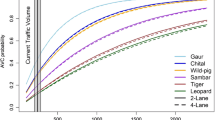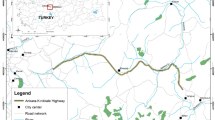Abstract
Traffic has a considerable effect on population and community dynamics through the disruption and fragmentation of habitat and traffic mortality. This paper deals with a systematic way to acquire knowledge about the probabilities of successful road crossing by mammals and what characteristics affect this traversability. We derive a model from traffic flow theory to estimate traffic mortality in mammals related to relevant road, traffic and species characteristics. The probability of successful road crossing is determined by the pavement width of the road, traffic volume, traversing speed of the mammals and their body length. We include the traversability model in a simple two-patch population model to explore the effects of these road, traffic and species characteristics on population dynamics. Analysis of the models show that, for our parameter ranges, traffic volume and traversing speed have the largest effect on traffic mortality. The population size is especially negatively affected when roads have to be crossed during the daily movements. These predictions could be useful to determine the expected effectiveness of mitigating measures relative to the current situation. Mitigating measures might alter the road and traffic characteristics. The effects of these changes on traffic mortality and population dynamics could be analysed by calculating the number of traffic victims before and after the mitigating measures.
Similar content being viewed by others
References
Adams L.W. and Geis A.D. 1983. Effects of roads on small mammals. Journal of Applied Ecology 20: 403–15.
Amarasekare P. 1998. Interactions between local dynamics and dispersal: insights from single species models. Theoretical Population Biology 53: 44–59.
Andrews A. 1990. Fragmentation of habitat by roads and utility corridors: a review. Australian Zoologist 26: 130–141.
Baerwald J.E. 1976. Transportation and Engineering Handbook. Prentice Hall, Englewood Cliffs, New Jersey, USA.
Botma H. 1986. Traffic operation on busy two-lane roads in the Netherlands. In: Transportation Research Record 1091. TRB, National Research Council, Washington DC, USA, 126–131.
Clarke G.P., White P.C.L. and Harris S. 1998. Effects of roads on badger Meles meles populations in south-west England. Biological Conservation 86: 117–124.
Clevenger A.P., Chruszcz B. and Gunson K.E. 2003. Spatial patterns and factors influencing small vertebrate fauna roadkill aggregations. Biological Conservation 109: 15–26.
Davies J.M., Roper T.J. and Shepherdson D.J. 1987. Seasonal distribution of road kills in the European badger (Meles meles). Journal of Zoology 211: 525–9.
Drew D.R. 1968. Traffic flow theory and control. McGraw-Hill, New York, New York, USA, 467 pp.
Edelstein-Keshet L., 1988. Mathematical Models in Biology. McGraw-Hill, New York, New York, USA.
Forman R.T.T. and Alexander L.E. 1998. Roads and their major ecological effects. Annual Review of ecology and systematics 29: 207–231.
Garret L.C. and Conway G.A. 1999. Characteristics of moose-vehicle collisions in Anchorage, Alaska, 1991-1995. Journal of Safety Research 30: 219–223.
Groot Bruinderink G.W.T.A. and Hazebroek E. 1996. Ungulate traffic collisions in Europe. Conservation Biology 10: 1059–1067.
Haight F.A. 1963. Mathematical Theories of traffic flow. Academic Press, London, UK.
Haight F.A. 1966. Handbook of the Poisson distribution. John Wiley and Sons, New York, New York, USA.
Harders J. 1968. Die Leistungsfaehigkeit nicht signalgeregelter staedtischer Verkehrsknote. Strassenbau und Strassenverkehrstechnik Heft 76.
Hels T. and Buchwald E. 2001. The effect of road kills on amphibian populations. Biological Conservation 99: 331–340.
Huijser M.P. and Bergers P.J.M. 2000. The effect of roads and traffic on hedgehog (Erinaceus europaneus) populations. Biological Conservation 95: 111–116.
Hunt J. and Abduljabbar J. 1993. Crossing the road: a method of assessing pedestrian crossing difficulty. Traffic Engineering + Control 11: 526–31.
Jaarsma C.F. and van Langevelde F. 1997. Right-of-Way Manage-ment and habitat fragmentation: an integral approach with the spatial concept of the Traffic Calmed Rural Area. In: Hydro-Quebec Centre de Documentation Environnement (ed.), Environmental Concerns in Rights-of-way Management. Proceedings of the 6th International Symposium, 24-26 February. Elsevier Science, New Orleans, Louisiana, USA, pp 383-392.
Jackson S.D. and Griffin C.R. 1998. Toward a practical strategy for mitigating highway impacts on wildlife. In: Evink G.L., Garrett P., Zeigler D. and Berry J. (eds), Proceedings of the International Conference on Wildlife Ecology and Transportation. Florida Department of Transportation, Tallahassee, Florida, USA, pp. 17-22.
Keller V. and Pfister H.P. 1997. Wildlife passages as a means of mitigating effects of habitat fragmentation by roads and railway lines. In:Kanters K.J., Piepers A. and Hendriks-Heersma D. (eds), Habitat fragmentation and infrastructure. Proceedings of the International Conference on Habitat Fragmentation, infrastructure and the role of ecological engineering. Maastricht/The Hague, The Netherlands, pp. 70–80.
Kirby K.J. 1997. Habitat fragmentation and infrastructure: problems and research. In: Kanters K.J., Piepers A. and Hendriks-Heersma D. (eds), Habitat fragmentation and infrastructure. Proceedings of the International Conference on Habitat Fragmentation, infrastructure and the role of ecological engineering. Maastricht/The Hague, Netherlands, pp. 32-39.
Lange R., Twisk P., van Winden A. and van Diepenveen A. 1994. Zoogdieren van West-Europa. KNNV, Utrecht, Netherlands.
Lankester K., van Apeldoorn R., Meelis E. and Verboom J. 1991. Management perspectives for populations of the Eurasian badger (Meles meles) in a fragmented landscape. Journal of Applied Ecology 28: 561–73.
Leutzbach W. 1988. Introduction to the theory of traffic flow. Springer-Verlag, Berlin, 204 pp.
Mader H.J., 1984. Animal habitat isolation by roads and agricultural fields. Biological Conservation 29: 81–96.
Munguira M.L. and Thomas J.A. 1992. Use of road verges by butterfly and burnet populations, and the effect of roads on adult dispersal and mortality. Journal of Applied Ecology 29: 316–329.
OECD (Organisation for Economic Cooperation and Development) 1986. Economic design of low-traffic roads. Paris, France.
Oxley D.J., Fenton M.B. and Carmody G.R. 1974. The effects of roads on populations of small mammals. Journal of Applied Ecology 11: 51–59.
Peters R.H. 1983. The ecological implications of body size. Cambridge University Press, Cambridge, UK.
Putman R.J. 1997. Deer and road traffic accidents: options for management. Journal of Environmental Management 51: 43–57.
Romin L.A. and Bissonnette J.A. 1996. Deer-vehicle collisions: status of state monitoring activities and mitigation efforts. Wild-life Society Bulletin 24: 276–283.
Singh A.P. and Satheesan S.M. 2000. Designing railroads, highways and canals in Protected Areas to reduce man-elephant conflicts. Paper presented at the 7th International Symposium on Environmental Concerns in Rights-of-way Management. Cal-gary, Alberta, Canada, September 9-13.
Spellerberg I.F. 1998. Ecological effects of roads and traffic: a literature review. Global Ecology and Biography Letters 7: 317–333.
Trombulak S.C. and Frissell C.A. 2000. Review of ecological effects of roads on terrestrial and aquatic communities. Conservation Biology 14: 18–30.
Van Bohemen H.D. 1998. Habitat fragmentation, infrastructure and ecological engineering. Ecological Engineering 11: 199–207.
Van Langevelde F. and Jaarsma C.F. 1997. Habitat fragmentation, the role of minor rural roads and their traversability. In: Kanters K.J., Piepers A. and Hendriks-Heersma D. (eds), Habitat fragmentation and infrastructure. Proceedings of the International Conference on Habitat Fragmentation, infrastructure and the role of ecological engineering. Maastricht/The Hague, Netherlands, pp. 171-182.
Vermeulen H.J.W. 1994. Corridor function of a road verge for dispersal of stenotopic heathland ground beetles (Carabidae). Biological Conservation 3: 339–49.
Author information
Authors and Affiliations
Rights and permissions
About this article
Cite this article
van Langevelde, F., Jaarsma, C.F. Using traffic flow theory to model traffic mortality in mammals. Landscape Ecology 19, 895–907 (2004). https://doi.org/10.1007/s10980-004-0464-z
Issue Date:
DOI: https://doi.org/10.1007/s10980-004-0464-z




